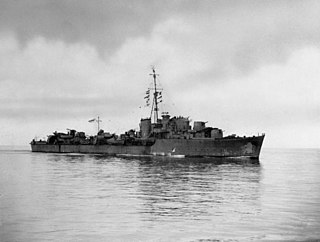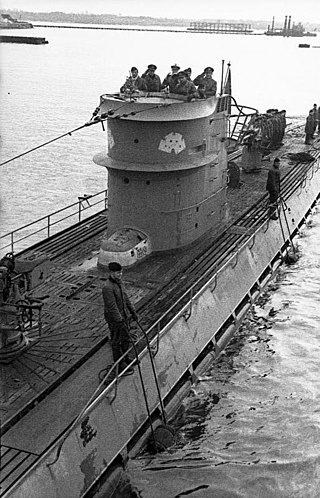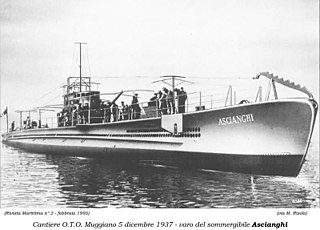
HMS Panther was a P-class destroyer built for the Royal Navy during the Second World War. After commissioning on 12 December 1941, she made a short trip to Iceland with the battleship King George V, then escorted a British convoy to India. In early April 1942, Panther rescued survivors from two cruisers sunk in the Indian Ocean, after which she took part in Operation Ironclad, the Allied invasion of Vichy French-held Madagascar, and sank a French submarine with another destroyer. Panther then returned to the Mediterranean, and participated in the Allied landings in North Africa, but was severely damaged in an air attack and had to undergo repairs in Gibraltar. After taking on survivors from the torpedoed SS Strathallan, Panther escorted two Allied convoys in the Atlantic. She next supported the Allied attack on Sicily, then sailed to the Aegean Sea in the Dodecanese Campaign. On 9 October 1943, Panther was sunk by German Stuka dive-bombers with 33 dead.

The Northern Patrol, also known as Cruiser Force B and the Northern Patrol Force, was an operation of the British Royal Navy during the First World War and Second World War. The Patrol was part of the British "distant" blockade of Germany. Its main task was to prevent trade to and from Germany by checking merchant ships and their cargoes. It was also to stop German warships, raiders and other German naval ships from leaving the North Sea for the Atlantic Ocean or entering the North Sea from the Atlantic, protect Shetland against invasion and to gather intelligence from intercepted neutral ships.

RMS Carmania was a Cunard Line transatlantic steam turbine ocean liner. She was launched in 1905 and scrapped in 1932. In World War I she was first an armed merchant cruiser (AMC) and then a troop ship.

HMS Salmon was a second-batch S-class submarine built during the 1930s for the Royal Navy. Completed in 1935, the boat fought in the Second World War. Salmon is one of twelve boats named in the song "Twelve Little S-Boats".
RMS Antonia and her sister ship Andania were the first two of the six 14,000 ton "A" ocean liners built for Cunard in the early 1920s.

HMS Natal was a Warrior-class armoured cruiser built for the Royal Navy in the first decade of the 20th century. She escorted the royal yacht in 1911–1912 for the newly crowned King George V's trip to India to attend the Delhi Durbar. During World War I the ship was assigned to the 2nd Cruiser Squadron of the Grand Fleet, but did not participate in any battles. Natal was sunk by an internal explosion near Cromarty on 30 December 1915 with the loss of at least 390 crewmen and civilians. Most of her wreck was slowly salvaged over the decades until the remnants were demolished in the 1970s so they were no longer a hazard to navigation. The remains of her wreck are designated as a controlled site under the Protection of Military Remains Act 1986 as a war grave.

HMS Simoom was a third-batch S-class submarine built for the Royal Navy during World War II. She was laid down on 14 July 1941 and launched on 12 October 1942.

RMS Alaunia was an ocean liner owned by the Cunard Line. She was built in 1913 at Greenock and measured 13,405 tons gross. She was one of the three ships Cunard ordered Scotts Shipbuilding and Engineering Company to build. These three ships were RMS Andania, Alaunia, and RMS Aurania. The Alaunia was the second of these three ships. She and her sisters had only 2nd class and 3rd class.

German submarine U-74 was a Type VIIB U-boat of Nazi Germany's Kriegsmarine during World War II.

RMS Ausonia, launched in 1921, was one of Cunard's six post-World War I "A-class" ocean liners for the Canadian service.

RMS Aurania was an ocean liner owned by the Cunard Line. She was built in 1916 at Wallsend and measured 13,936 gross register tons.

HMS Artifex was a repair ship of the Royal Navy from late in the Second World War and into the Cold War. Launched as the Cunard liner RMS Aurania she was requisitioned on the outbreak of war to serve as an armed merchant cruiser. Damaged by a U-boat while sailing with an Atlantic convoy, she was purchased outright and converted to a floating workshop, spending the rest of her life as a support ship for the navy.

RMS Andania was a passenger-cargo ship built by Scotts Shipbuilding and Engineering Company of Greenock. She was launched on 22 March 1913 and was completed on 13 July 1913.

The action of 4 April 1941 was a naval engagement fought during the Battle of the Atlantic during the Second World War. A German commerce raider, Thor, encountered the British armed merchant cruiser HMS Voltaire and sank her after a short engagement. The German crew rescued the British survivors, some of whom were repatriated and gave an account to the Admiralty. It was accepted that German commerce raiders were too well armed for converted ocean liners equipped with obsolete guns but nothing else was available to the Royal Navy until later in the war.

The RMS Ascania was an ocean liner operated by the Cunard Line. She was launched on 20 December 1923 at the Armstrong Whitworth Shipbuilders Ltd yard in Newcastle-upon-Tyne; the fifth of Cunard's six "A" class liners. Due to unforeseen cost overruns, the vessel was not completed until May 1925. Following service in a number of military roles during the Second World War, she was refitted and returned to civilian use in 1950, finally retiring in 1956.

Captain John Treasure Jones was a British naval officer who became a well-known media figure in the mid-1960s following his appointment as the last master of the Cunard liner, RMS Queen Mary. He has been described as one of the 20th century's most distinguished mariners, in war and in peacetime. His forebears were men of the sea, who had captained sailing ships, and he elected to follow in their tradition.

German submarine U-108 was a Type IXB U-boat of Nazi Germany's Kriegsmarine that operated during World War II. She was laid down at DeSchiMAG AG Weser in Bremen as yard number 971 on 27 December 1938, launched on 15 July 1940 and commissioned on 22 October under Korvettenkapitän Klaus Scholtz.

I-65, later renumbered I-165, was an Imperial Japanese Navy Kaidai type cruiser submarine commissioned in 1932. A KD5 sub-class submarine, she served during World War II, supporting Japanese forces in the invasion of Malaya and the Dutch East Indies campaign, participating in the Battle of Midway, and patrolling in the Indian Ocean and Pacific Ocean before she was sunk in 1945. In 1944, her crew committed a war crime, massacring the survivors of the merchant ship Nancy Moller.

Italian submarine Ascianghi was an Adua-class submarine built for the Royal Italian Navy during the 1930s. It was named after Lake Ashenge in Ethiopia.
RMS Caledonia was a British ocean liner built by Alexander Stephen and Sons for the Anchor Line which was converted into an armed merchant cruiser during World War II.


















